Job interviews are one of the most important parts of the hiring process, yet so many companies get them wrong. Inconsistent questions, a tendency for bias, asking the wrong questions, and having too many (or too few) people in the interview — all common reasons for poor hiring outcomes.
The reason? Several, but most companies lack the key — an interview guide.
If you’re a recruitment professional struggling to attract and retain top talent, it’s important to learn the art and science of developing an effective interview guide that will streamline your hiring process, facilitate better candidate assessment, and ultimately lead to top-tier talent acquisition.
TL;DR — Key Takeaways
An interview guide is a set of instructions and guidelines on how to run job interviews successfully.
These guides keep the interview process organized, improve the candidate experience, and reduce hiring bias.
Some of the key components of a good interview guide are interview information, candidate information, interview introduction, interview questions, role-specific questions, candidate scorecard, and a few minutes for the candidate to ask their own questions.
To create better interview guides, have a scoring system, follow legal guidelines, and train your hiring managers. Using a template that’s been customized to fit your hiring needs and brand helps, too.
What is an interview guide?
For 72% of candidates, the smoothness of the interview process affects their decision whether or not to take the job. So, if you want to attract the best candidate, you need a structured, effective job interview process.
One of the easiest ways to achieve that is to use an interview guide, which is a set of interview questions and guidelines designed to prepare HR professionals to run successful job interviews.
Sometimes called a job interview template, this guide helps the hiring manager or recruiter ask the right questions to the job candidates, all the while improving the candidate experience.
Benefits of using an interview guide
Hiring teams, both big and small, benefit from using interview guides. However, the benefits vary depending on your hiring goals, the interview templates used, and a few other factors. Here are a few of the biggest benefits for any team and role.
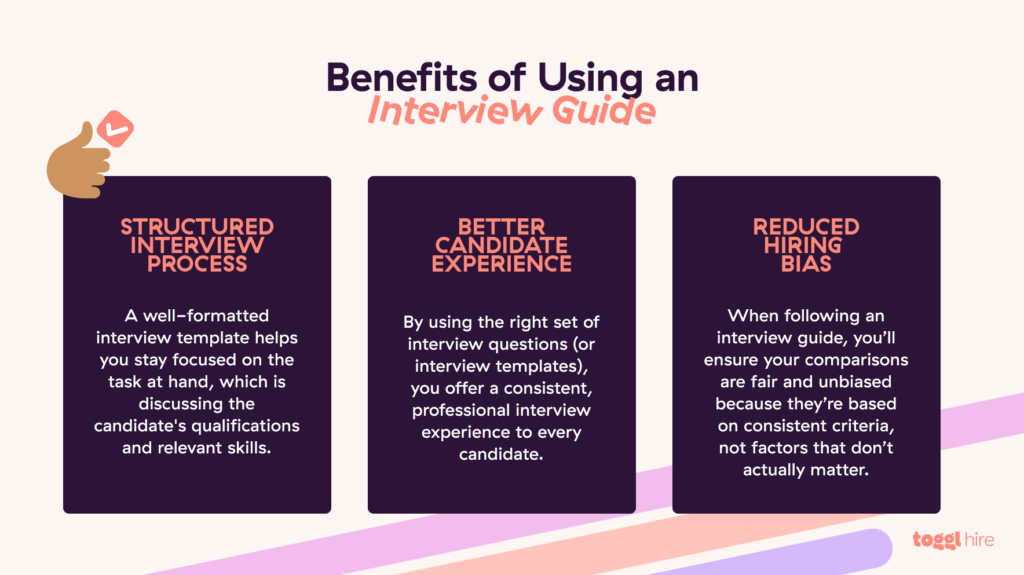
Structured interview process
A job interview isn’t a casual chat with a friend from school. It’s a set of carefully selected interview questions designed to help streamline the process and assess applicants for the position you’re hiring for. When using an interview guide, you ensure every job candidate has the same interview experience.
A well-formatted interview template helps you stay focused on the task at hand, which is discussing the candidate’s qualifications and relevant skills instead of straying off and chatting about where they grew up and why Americans call football soccer.
With a clear structure and pre-planned questions, you offer the same interview experience whether you’re conducting two interviews or twenty. This makes comparing candidates easier and reduces the chances of any bias.
Better candidate experience
Job interviews aren’t just about vetting candidates to see who’s best for the role. They’re also a way for candidates to assess the company culture and what it would be like to work with you. An interview guide is a helpful tool if you want to offer a great experience and demonstrate a professional employer brand.
By using the right set of interview questions (or interview templates), you avoid repetitive and irrelevant questions that might put the candidate off. With a structured interview format, the candidates know they’re dealing with a professional, organized company — or at least a great hiring team.
Reduced hiring bias
Candidates with a criminal background are 50% less likely to receive a job offer, and 89% of hiring managers make judgments about applicants within the first 15 minutes of an interview.
A structured set of interview questions helps reduce some of this unconscious bias. The reason is simple — every candidate is asked the same questions, regardless of their background. Using an interview template helps with diversity, inclusion, and fairness in your recruitment process.
You want to find someone who matches your ideal candidate profile, but not at the cost of being biased.
Key components of an interview guide
Every company is unique, from the culture to the leadership and management team, all the way to their hiring needs.
As such, interview guides and interview templates should be custom-tailored for your individual business. Moreover, they should fit the individual role and the job description you’re hiring for.
However, there are some common components that all interview guides should have, including the following…
Interview information
Every interview guide should start with the basics:
The date and time of the interview
The location
The people attending the interview
The roles they will be playing in the interview process
List all of this information at the top of the document, along with the purpose of the interview. This helps align all the collaborators in your hiring team, as well as keep them on the same page (especially if you’re conducting dozens of interviews at a time).
Candidate information
Basic candidate information is a mandatory part of every good interview template.
Include the candidate’s name and contact information, as well as the position they’re being interviewed for. This keeps all the interviewers and team members aligned and prevents embarrassing situations like using the wrong name.
Additionally, add a brief summary of who the candidate is — their core competencies, educational background, and a short work history. That way, you don’t ask the candidate questions about matters that should already be familiar at this stage.
Interviewer introduction
Before moving on with the interview questions, you should introduce yourself. By that, we mean the interviewers and their roles and responsibilities. After that, move on to the company — what it does, what kinds of problems it solves, and for whom.
You can keep this part identical for just about every role you hire for. Your interviews can remember it word for word to keep things easy (although they should avoid sounding robotic), or if you’re working with newer interviewers, you can create a checklist they can tick off as they go through each interview.
Interview questions
The most important part of the interview guide is the interview questions. For the best results, list a good mix of general and behavioral interview questions in the guide to keep the interviewer focused and on task.

You want to assess:
The candidate’s skills
Their previous work experience
Their cultural fit
The right structure of the questions will help you get the most insightful responses and find the right person. Try using the STAR method in your interview template:
Situation
Task
Action
Result
In short, ask them about a situation they were in, the task they were supposed to do, the action they took, and the results they were able to achieve.
Even if you don’t structure the question that way, you should still be listening for candidates who respond using the STAR method.
Role-specific questions
Can the candidate do everything in the job description (or at least the majority of things)? In most interview templates, these are the questions that make or break the candidate’s success.
Take a look at the candidate’s resume and ask about previous roles they worked in and the duties they had while there. Ask about the people they managed to assess their leadership skills, as well as organizational skills.
While these aren’t a 100% guarantee that the candidate can do what they claim, they’re a decent starting point for your interview process.
Candidate scorecard
Near the end of good interview templates, there should be a block of space for interviewer notes. Beside that space should be a candidate scorecard.
This can be a simple table that helps interviewers objectively grade and compare candidates on a scale. However you format it, both are critical! Having space for note-taking and a proper scorecard helps reduce bias and reach a better hiring decision.
You don’t have to build a candidate scorecard from scratch. Download our free template here!
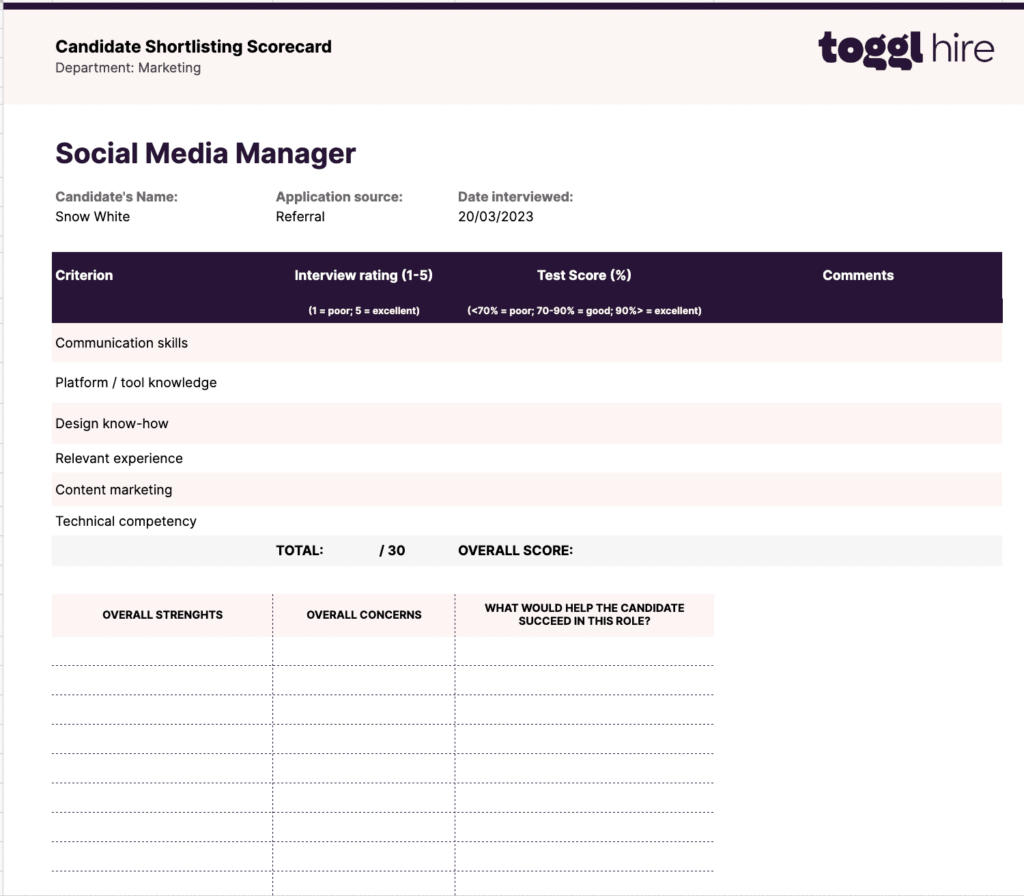
Candidate questions
Leave time for the candidates to ask questions and encourage them to do so. They’ll likely want to learn more about what the position entails, what the work environment is like, what your selection criteria are, and more.
The questions that applicants ask can tell you a lot about their priorities and interests and how engaged and excited they are to join your team.
Wrapping up
At the very end, there’s just one more element in the interview format — the wrap-up section. Summarize how the interview went, give some feedback to the candidate, and give them basic information about the next steps in the hiring process.
You can also include a sample thank-you note in your interview guide that hiring managers can send after the interview, thanking them for their time.
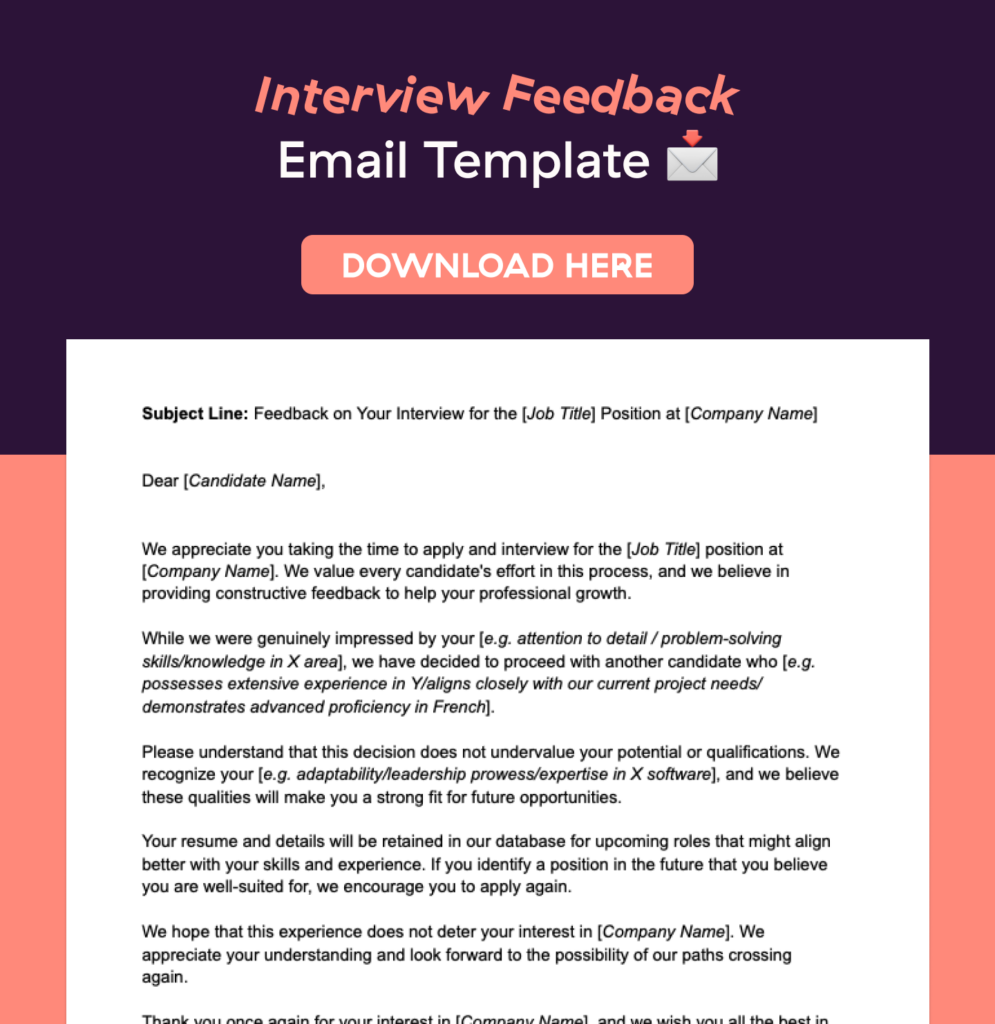
Questions to include in a job interview template
The questions you ask will largely depend on the stage of the hiring process the candidate is in. Typically, every new position requires at least one, but in some cases, multiple interviews.
Behavioral questions are an excellent way to understand what a candidate can and cannot do, as well as what their personality is all about.
Here are a few good general ones you can include at the beginning of the interview process:
Tell me about a time you had to meet a tight deadline before. How did you handle the situation and the stress, and what was the end result?
Tell me about a time when you had to quickly pick up a new skill in a specific position. How did you do it, and what was the end result?
Tell me about a time when you had to resolve a conflict in your team. What methods did you use?
If you haven’t asked the candidates to do a skills test before the interview, now is a good time to ask questions about the required skills for the job — technical and role-specific skills.
Here’s an example of a great question that sets each candidate up for answering using the ever-popular STAR method:
In your role as the sales team lead at your previous company, you increased the number of closed won opportunities by 30%. Can you guide me through the process and explain the processes involved to get to this result?
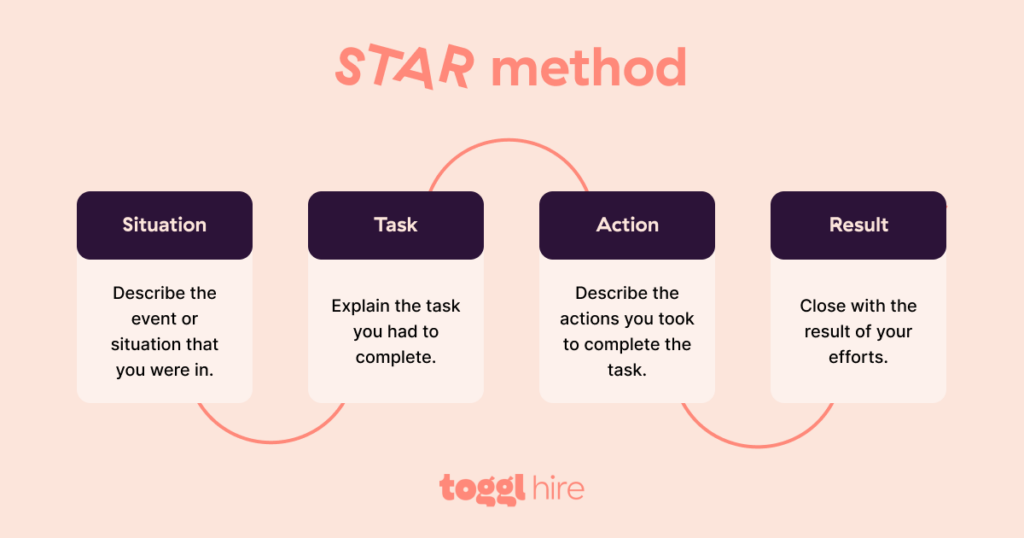
Tips for creating better interview guides
If you’ve never created interview guides for your open positions before, here are some handy tips and specific examples of what (and what not) to include for the best results.
Use an interview scoring system
Develop your own scoring system when interviewing candidates for various roles, ideally a specialized one for each role you’re trying to fill. This doesn’t have to be anything fancy, either. A simple sheet works just fine!
List job-related criteria such as past experiences, interview performance, references, and more. This makes the decision-making process simpler once everybody’s reached the final stage and it’s time to compare top candidates.
Follow legal and ethical guidelines
There are certain questions you should never ask, as they could get you in trouble. Before putting together an interview guide, ensure you’re up to date on your federal, regional, and state hiring laws.
While you want to avoid legal issues, understanding your legal and ethical boundaries when conducting interviews is simply the right thing to do. Try to treat every candidate equally while preserving their privacy and confidentiality.
Train your hiring managers
An interview guide that no one uses is quite literally, well, useless. To make the most out of it, train your team on how to use it, and make the most out of it.
The goal should be to ensure that for every specific role, there’s consistency in questions and the interview format. You can include this as part of general interview training, as this is a great way for interviewers to understand the purpose of every element in the interview guide.
Interview guide template
No time to create an interview template? We feel ya — and we sympathize with you so much that we’re going to let you steal ours.
Below you can grab a completely free interview guide template, and with just a few tweaks and edits, you can create your own interview guide in less time than it takes to eat lunch. Remember, this is just an interview guide with the basics. It’s up to you to make it pop.
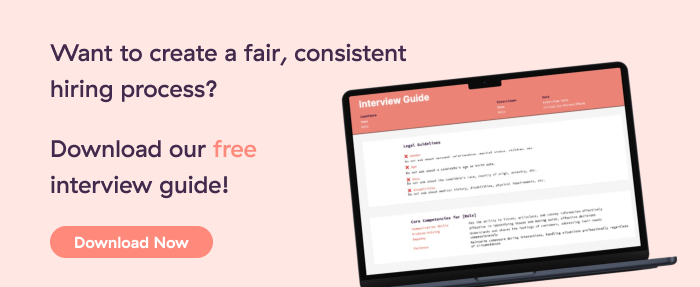
Improve your hiring process with Toggl Hire
An interview guide is a key hiring tool that helps everyone on the team stay aligned and make better, more objective hiring decisions.
Sometimes, however, interviews alone aren’t enough to make confident hiring decisions. When you want to find out if someone really has what it takes to succeed on the job, you need to assess their skills, too.
With Toggl Hire, you can streamline and improve the hiring process by putting the job assessment before the interview. Use a skills test to ensure you’re talking to the right candidates every time.
Create a free Toggl Hire account today and get started!
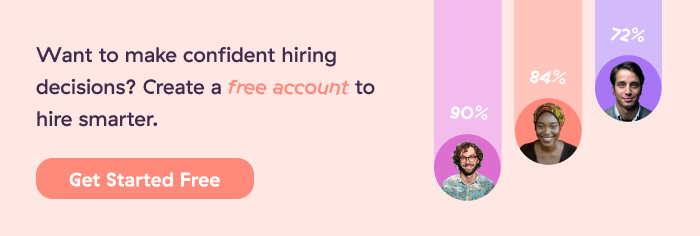
Mile is a B2B content marketer specializing in HR, martech and data analytics. Ask him about thoughts on reducing hiring bias, the role of AI in modern recruitment, or how to immediately spot red flags in a job ad.




